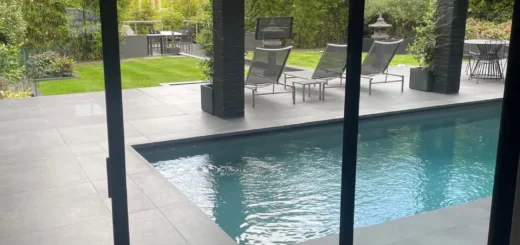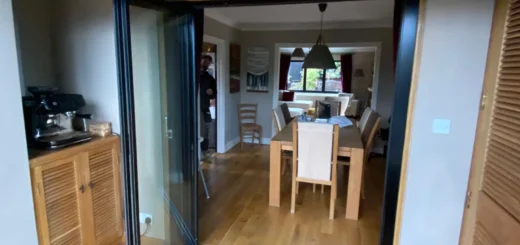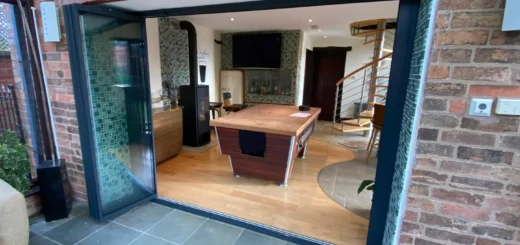External Glass Doors: Style and Selection Guide
Table of Contents
Comparing Types of External Glass Doors
Modern external glass doors have moved far beyond basic French doors and windows, with new systems offering wider openings and better views of outdoor spaces.
Sliding Patio Doors
Glass sliding doors remain a popular choice among British homeowners, particularly where space comes at a premium. Moving smoothly along precision-engineered tracks, these doors stack neatly behind one another to open up roughly two-thirds of the total frame width. The minimal frame profiles make sliding doors especially suited to rooms where you want to preserve views of the garden year-round.
Most sliding door panels measure between 1-2 metres wide, with multi-panel configurations spanning broader openings. The panels glide independently, letting you adjust the opening size based on weather conditions or ventilation needs. Double-glazed units with thermal breaks in the frames help maintain comfortable indoor temperatures regardless of the season.
External Bifold Doors
Bifold doors fold back in a concertina pattern, with panels hinged together in pairs or groups. Unlike sliding systems, bifolding doors can open up nearly the entire frame width, making them perfect for wide apertures between house and garden. The panels stack neatly at one or both sides when fully opened.
Modern bifold systems feature slim sight lines and robust roller mechanisms that ensure reliable operation over many years. Top-hung designs carry the door weight through the header frame rather than the threshold, reducing wear on floor-mounted components. Multi-point locking mechanisms on the main traffic door provide security equal to standard external doors.
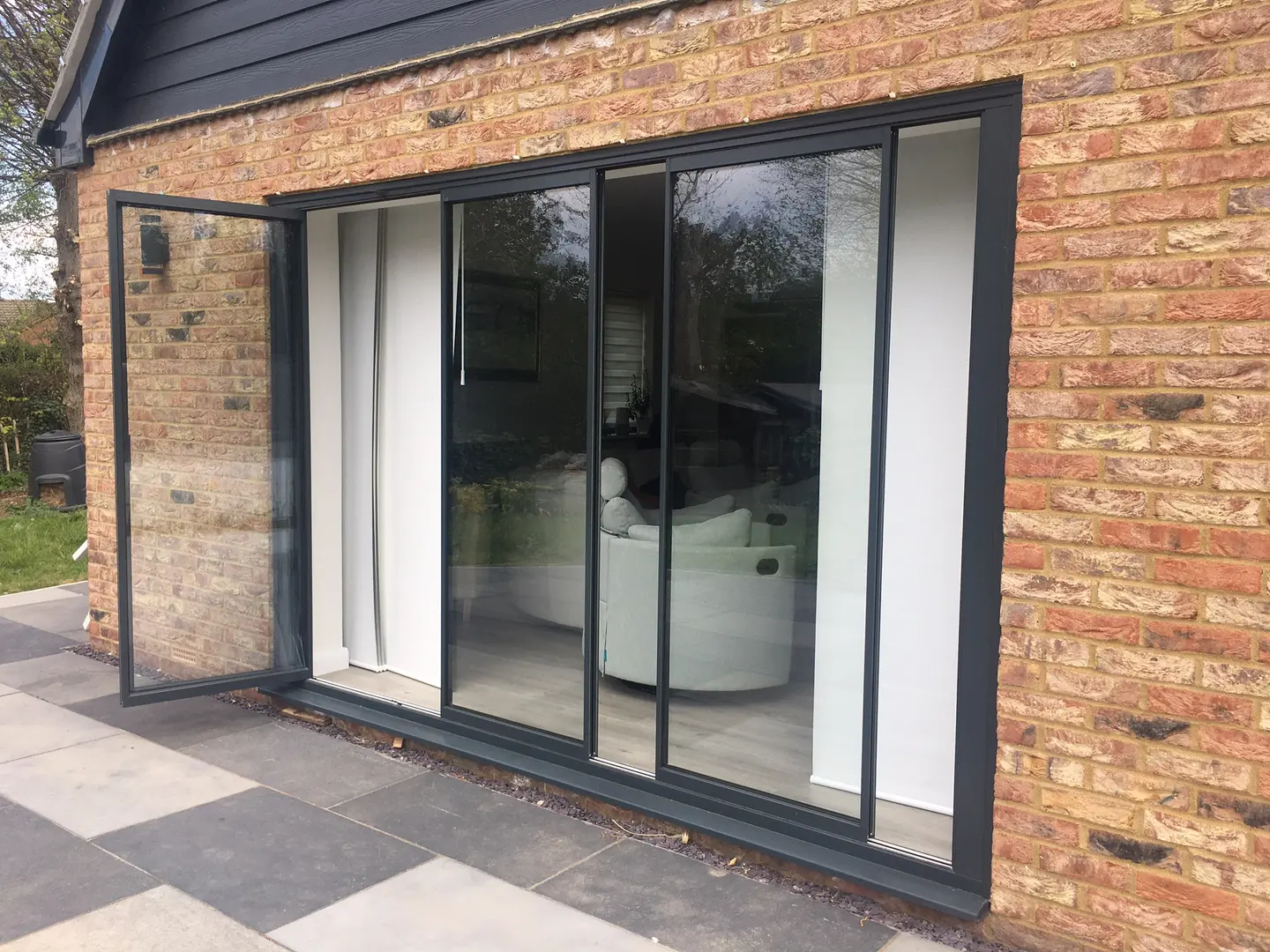
Slide and Stack Doors
Slide and stack doors combine sliding and pivoting movements. The panels first slide along a track, then pivot and stack perpendicular to the frame. This design allows for wider openings than standard sliding doors while maintaining a clean look when closed.
The panels require slightly more clearance space than some other systems due to their perpendicular stacking position. However, this arrangement lets you position furniture closer to the doors than would be possible with bifolds. The smooth operation makes these doors particularly suitable for kitchen-dining spaces that open onto patios or decking.
Frame Configurations
Glass external doors can be configured with varying numbers of panels based on the opening width and desired functionality. Two-panel sliding doors suit smaller spaces, while larger openings may use three, four or more panels. Corner posts can sometimes be removed to allow doors to meet at right angles, though this requires additional structural considerations.
Style Guide to External Glass Doors
Style choices in external glass doors can shape the character of your home, with options ranging from ultra-modern to period-appropriate designs.
Slimline Frames
Modern manufacturing techniques allow for incredibly thin door frames without sacrificing strength or security. Slimline sliding doors feature frame profiles as slim as 20mm, nearly doubling the glass area compared to standard frames. Architects often specify these minimal frames to maintain clean sightlines through the glass, particularly in new extensions where the doors serve as a visual centrepiece.
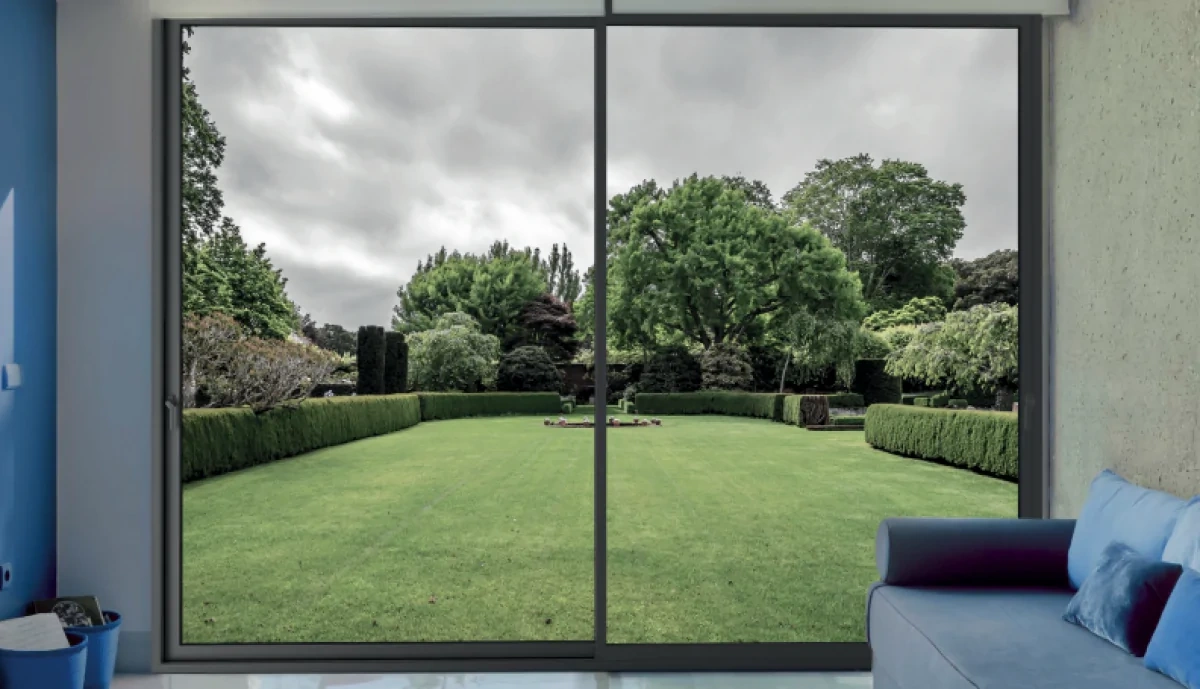
The reduced frame bulk creates an almost frameless appearance when viewed from inside, while maintaining the thermal performance needed for British weather. Powder coated aluminium doors in dark grey or black colours tend to visually recede against the glass, amplifying this minimal aesthetic. These slim frames work especially well in contemporary homes where large glass panels complement other architectural features.
Thermal breaks within the frames prevent heat transfer between internal and external surfaces, ensuring the metal frames stay comfortable to touch even in cold weather. Multiple weather seals around each panel keep out draughts without adding visible bulk to the frame sections.
Heritage-Style Glass Doors
Period properties demand more traditional designs, which is where heritage style doors shine. These external glass doors recreate the proportions and details of original Victorian and Edwardian glazing while offering modern performance. Deeper frame profiles, mullion bars, and decorative glazing beads match the architectural style of older homes.
The frames typically feature traditional joinery details like ovolo beading and stepped sightlines. Even modern materials like aluminium can be finished to mimic traditional painted timber, complete with textured surfaces that add depth and character. These subtle touches help glass external doors harmonise with existing windows and architectural features.
Glazing Options
Heritage designs often include horizontal glazing bars or Georgian-style grids that divide each panel into smaller panes. While some systems use stuck-on bars, higher-quality doors may use true internal spacer bars between the glass panes (these are known as integral bars). This authentic approach creates genuine shadow lines and depth, matching the appearance of traditional single-glazed windows.
Contemporary Minimal Designs
Floor-to-ceiling panels increase natural light penetration, while concealed frames can be plastered directly into walls for a streamlined look. Track systems recess into the floor, creating level thresholds that blur the boundary between inside and out.
Hidden rollers and discrete handles maintain clean lines without compromising usability. Magnetic door catches eliminate the need for visible locks on secondary panels. Even drainage channels and threshold tracks can be concealed within the flooring, though proper planning during installation remains essential.
Lower frame heights reduce visual barriers while maintaining water tightness. Some systems achieve this through additional drainage channels and custom-designed sill sections. Premium hardware allows for smooth operation despite the reduced frame size, with stainless steel rollers and precision-machined tracks ensuring reliable movement.
Flush thresholds create continuous flooring between spaces, though they require careful installation to manage water runoff. Channel drainage systems beneath the threshold help prevent water ingress during heavy rain. Some manufacturers offer ramped threshold options that balance accessibility with weather protection.
Flush Thresholds
Low-profile thresholds deserve special attention when selecting external glass doors for ground-floor spaces. Standard door thresholds can present trip hazards and interrupt the visual flow of flooring.
Drainage channels beneath the threshold collect any water that makes it past the seals, directing it away from the interior. Some systems include secondary drainage paths as backup protection. The threshold height can often be adjusted during installation to match different flooring materials on either side of the door.
External Glass Doors for Different Room Types
Placing external glass doors requires careful thought about how each room connects to outdoor spaces, from busy kitchens to peaceful bedrooms.
Kitchen Garden Doors
Modern kitchens often extend into garden spaces, making the choice of doors particularly important. External glass kitchen doors need to withstand frequent use while providing good ventilation for cooking. Larger panels can make moving items between indoor and outdoor dining areas easier, though the door weight increases with panel size.
Panel configuration matters more in kitchens than other rooms. A single traffic door within a multi-panel system lets you pop out briefly without opening the entire door set. This proves especially useful when carrying plates or drinks to an outdoor dining area. Traffic doors should swing rather than slide, allowing quick access even with full hands.
Threshold design becomes even more important in kitchen spaces where spills might occur. Raised thresholds offer better protection against water ingress but can impede movement when carrying items. Some external glass doors feature ramped threshold options that balance protection with practicality. Running the same flooring material inside and out can disguise necessary height differences while maintaining a cohesive look.
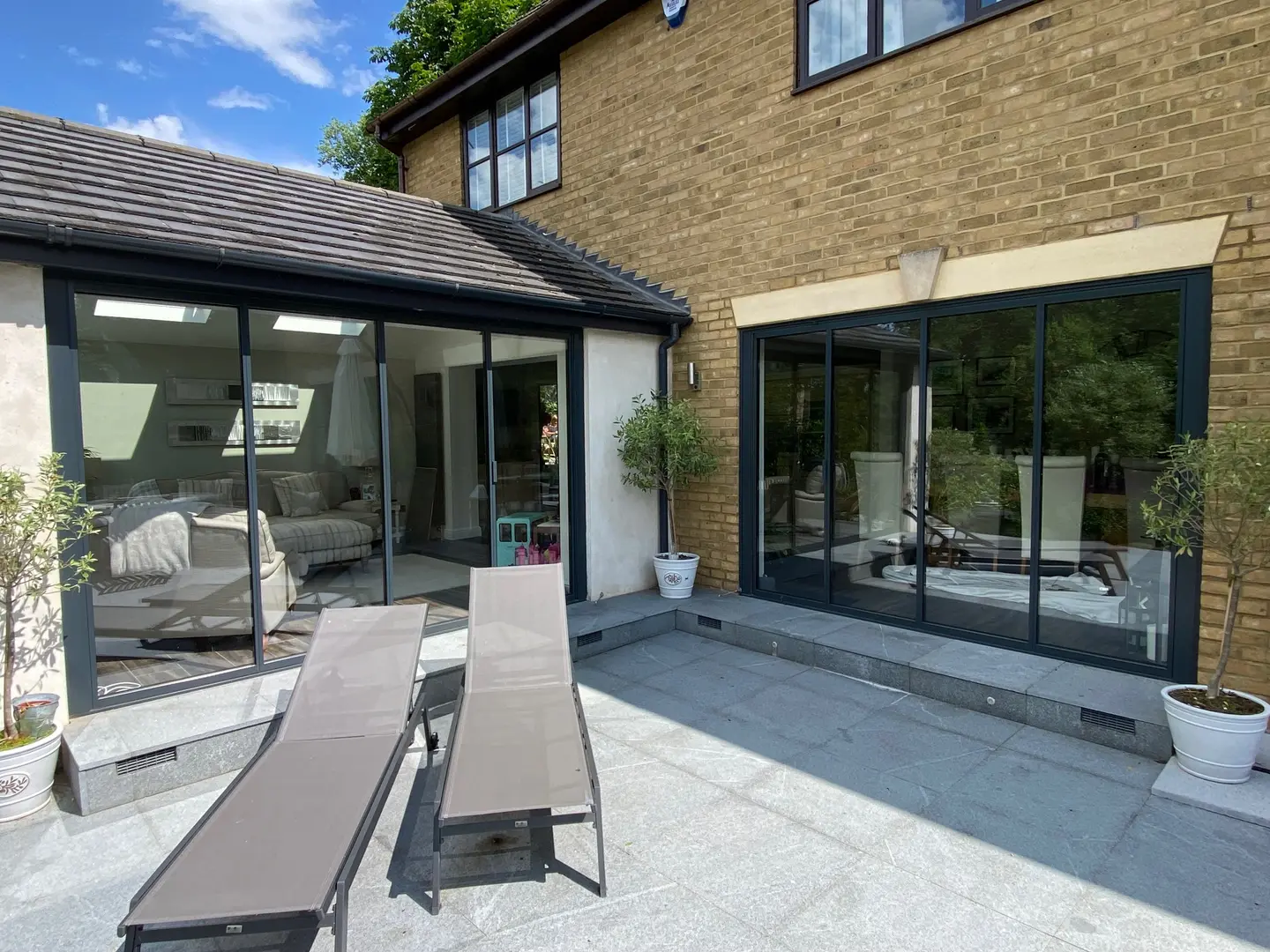
Living Room Garden Connections
Glass living room doors create striking views that change with the seasons. The visual connection to the garden extends the perceived size of the room, while modern glass coatings help maintain comfortable temperatures year-round.
Larger glass panels suit living spaces particularly well, as furniture placement typically leaves more wall space free for door systems.
Solar control glass helps prevent overheating in south-facing rooms without dampening natural light.
Furniture Placement
Door placement should account for typical furniture arrangements. External glass doors that slide rather than swing out give more flexibility with seating positions. The stack position of open door panels needs careful planning to avoid blocking prime viewing spots or creating awkward corners.
Bedroom Balcony Access
Upstairs rooms present unique requirements for external glass doors. Building regulations specify minimum balustrade heights and glass strength ratings for safety. Toughened and laminated glass panels provide extra protection against breakage while meeting these safety standards.
Ventilation options become more important in bedrooms, where temperature control aids good sleep. Multi-point locking systems allow secure night ventilation through partially open panels. Some glass external doors include integrated trickle vents that provide background airflow even when closed.
Privacy needs careful attention in bedroom installations. Obscured glass panels or integral blinds can provide privacy without blocking light. Door position relative to neighbouring properties warrants extra thought, particularly in urban areas where overlooking might occur.
Many homeowners opt for smaller door panels in upstairs rooms, making them lighter to operate. Restrictor arms can limit how far panels open, providing peace of mind on windy days. Handle height and operation should suit all household members, with easy-to-use mechanisms that don’t require excessive force.
Materials and Finishes for External Glass Doors
Material choice shapes the long-term performance of any door system, with modern options offering improved durability and reduced maintenance needs.
Aluminium vs uPVC Frames
Aluminium frames lead the market for external glass doors due to their strength-to-weight ratio and slim profiles. The material’s inherent rigidity allows for larger glass panels while maintaining narrow frame sections. Modern aluminium frames include thermal break technology – a non-metal barrier within the frame that prevents heat loss through the metal.
Raw aluminium starts as a silver-grey material but accepts a wide range of finishes through powder coating. The coating process creates a hard-wearing surface that resists scratches and fading. Marine-grade treatments provide extra protection in coastal areas where salt spray might damage lesser finishes.
uPVC can offer a cost-effective alternative for glass external doors, though frame sizes tend to be bulkier than aluminium. The material requires internal steel reinforcement to achieve similar structural strength, resulting in thicker frame sections. However, uPVC naturally insulates well and needs minimal maintenance beyond occasional cleaning.
Powder Coated External Glass Doors
Powder coating creates durable, colour-fast surfaces on aluminium external glass doors. The process involves electrostatically applying dry powder to the metal, then baking it to form a tough skin. This technique produces more consistent results than wet paint, with better resistance to chipping and peeling.
The range of available colours spans from subtle greys to bold statement shades. Textured finishes can mimic natural materials or create distinctive visual effects. Different gloss levels allow for varied appearances, from matt finishes that hide fingerprints to high-gloss surfaces that catch the light.
Metallic powder coatings contain tiny particles that create depth and sparkle in the finished surface. These premium finishes cost more than standard colours but offer unique visual appeal. The coating thickness varies between manufacturers, with higher-quality systems applying thicker layers for better durability.
Dual Colour Options
Dual colour finishes let homeowners match their external glass doors to different colour schemes inside and out. The outer face might complement existing window frames or brickwork, while the inner surface coordinates with interior paint colours. This flexibility proves particularly valuable in traditional homes where external planning restrictions might limit colour choices.
The manufacturing process for dual colour finishes requires extra steps to ensure proper adhesion on each surface. Premium systems use a two-stage powder coating process rather than applying different colours in a single pass. This method improves colour consistency and reduces the risk of cross-contamination between shades.
Customising External Glass Doors
Modern door systems offer numerous ways to personalise their appearance and operation while improving comfort year-round.
Integral Blinds
Remote-controlled blinds sealed within the glass unit provide adjustable privacy without cleaning hassles. The sealed environment protects the blinds from dust and damage, while magnetic operators allow smooth adjustment of the slat angle. These systems work particularly well in external glass doors where traditional curtains or blinds might impede operation.
The blinds sit within the cavity of double-glazed units, operated by discrete controls mounted on the frame edge. Solar-powered options eliminate the need for electrical connections, though battery replacement becomes necessary every few years. Manual systems use magnetic sliders that never wear out or need maintenance.
Some manufacturers offer different blind styles to suit varied privacy needs. Pleated blinds provide complete privacy when closed while folding into a compact stack when open. Venetian-style options give more control over light levels through adjustable slat angles. The colour of the blinds should complement the frame finish, as they become a permanent part of the door’s appearance.
Frame Colours
Black framed glass doors remain a popular choice for modern homes, creating strong architectural lines that frame garden views. The dark finish reduces the visual impact of gaskets and seals between glass panels while complementing contemporary interior styles. Darker frames also reduce glare reflection compared to lighter colours.
Neutral greys offer subtler alternatives that work well with most architectural styles. The shade choice can highlight or disguise the frames depending on the desired effect. Light grey frames appear less dominant than black while still providing clean lines against the glass. Textured finishes in these neutral shades help hide fingerprints and minor marks.
Paint manufacturers have developed specific colour ranges for external glass doors that account for heat absorption and expansion characteristics. Darker colours absorb more heat, which can cause thermal movement in the frames. High-quality systems use paint formulations that resist heat build-up while maintaining colour stability under intense sunlight.
Security Features
Multi-point locking systems secure the door at several points around the frame when closed. Additional security hooks engage automatically when the main lock operates, creating a tight seal that resists forced entry attempts. Glass panels in these doors use laminated safety glass that stays in place even if broken, providing extra protection against break-ins.
Glass Options
Modern glass technology offers various ways to control heat, light, and privacy in external glass doors. Low-emissivity coatings reflect heat back into rooms during winter while reducing solar gain in summer. These invisible coatings work alongside gas-filled cavities between glass panes to improve thermal performance.
Acoustic glass helps reduce noise transmission through glass external doors, particularly valuable in urban settings. Multiple layers of glass at different thicknesses disrupt sound waves, while special interlayers absorb vibration. The extra glass layers add weight to the doors but provide notable noise reduction compared to standard double glazing.
About SunSeeker Doors
With over 20 years of experience, SunSeeker Doors remains at the forefront of door design with our quality-tested patio doors and related products, including the bespoke UltraSlim aluminium slide and pivot door system, Frameless Glass Doors, and Slimline Sliding Glass Doors. All of our doors are suitable for both internal and external use.
To request a free quotation, please use our online form. You may also contact 01582 492730, or email info@sunseekerdoors.co.uk if you have any questions.


